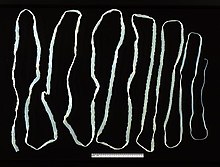Taenia (tapeworm)
| Taenia | |
|---|---|
 |
|
| Taenia saginata | |
| Scientific classification | |
| Kingdom: | Animalia |
| Phylum: | Platyhelminthes |
| Class: | Cestoda |
| Order: | Cyclophyllidea |
| Family: | Taeniidae |
| Genus: |
Taenia Linnaeus, 1758 |
| Type species | |
|
Taenia solium Linnaeus, 1758 |
|
Taenia is a genus of tapeworms (a type of helminth) that includes some important parasites of livestock. Members of the genus are responsible for taeniasis and cysticercosis in humans, which are a type of helminthiasis belonging to the group of neglected tropical diseases. More than 100 species are recorded. They are morphologically characterized by a ribbon-like body composed of a series of segments called proglottids; hence the name Taenia (Greek ταίνια, tainia meaning ribbon, bandage, or stripe). The anterior end of the body is the scolex. Not all members of the genus Taenia have an armed scolex (hooks and/or spines located in the "head" region), for example, Taenia saginata has an unarmed scolex, while Taenia solium has an armed scolex.
Proglottids have a central ovary, with a vitellarium (yolk gland) posterior to it. As in all cyclophyllid cestodes, a genital pore occurs on the side of the proglottid. Eggs are released when the proglottid deteriorates, so a uterine pore is unnecessary.
The lifecycle begins with either the gravid proglottids or free eggs (embryophores) with oncospheres (also known as hexacanth embryos) being passed in the feces, which can last for days to months in the environment. Sometimes, these segments will still be motile upon excretion—they either empty themselves of their eggs within a matter of minutes, or in some species, retain them as a cluster and await the arrival of a suitable intermediate vertebrate host. The intermediate host (cattle, pigs, rodents, etc., depending on the species) must then ingest the eggs or proglottids. If the host is a correct one for the particular species, the embriophores then hatch, and the hexacanth embryos invade the wall of the small intestine of the intermediate host to travel to the striated muscles to develop into cysticerci larvae. Here they grow, cavitate, and differentiate into the second larval form shaped like a bladder (and erroneously believed until the middle of the 19th century to be a separate parasite, the bladderworm) which is infectious to the definitive host when an invaginated protoscolex is completely developed. To continue the process, the definitive host must eat the uncooked meat of the intermediate host. Once in the small intestine of the definitive host, the bladder is digested away, the scolex embeds itself into the intestinal wall, and the neck begins to bud off segments to form the strobila. New eggs usually appear in the feces of the definitive host within 6 to 9 weeks, and the cycle repeats itself.
...
Wikipedia
